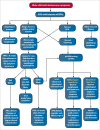The Spectrum of Reflux Phenotypes
Abstract
The focus on a symptom-based definition for gastroesophageal reflux disease (GERD) in adults and children has contributed to widespread use of acid suppression medications in patients with so-called typical reflux symptoms to treat the possibility of acid-mediated disease. Diagnostic testing with upper endoscopy, esophageal biopsies, ambulatory reflux monitoring, and/or esophageal manometry is often pursued when patients do not respond optimally to these medications. By using information from this diagnostic testing, GERD has shifted from a single diagnosis to a phenotypic spectrum, and each phenotype has unique pathophysiologic mechanisms driving symptom perception. Understanding these mechanisms is important to tailor individualized treatment plans and guide therapeutic interventions. The aim of this article is to discuss the different reflux phenotypes, the utility of esophageal reflux testing, the mechanisms underlying symptoms, and the management strategies for each phenotype.
Keywords: Multichannel intraluminal impedance; functional heartburn; nonerosive reflux disease; proton pump inhibitor; reflux hypersensitivity.
Copyright © 2019, Gastro-Hep Communications, Inc.
Conflict of interest statement
This work was supported by the NIH NIDDK R01 DK097112 (RR), the Thrasher Research Fund (LM), and the Boston Children’s Hospital Translational Research Program Senior Investigator Award (RR). The authors have no relevant conflicts of interest to disclose.
Figures

References
-
- Eusebi LH, Ratnakumaran R, Yuan Y, Solaymani-Dodaran M, Bazzoli F, Ford AC. Global prevalence of, and risk factors for, gastro-oesophageal reflux symptoms: a meta-analysis. Gut. 2018;67(3):430–440. - PubMed
-
- Singendonk M, Goudswaard E, Langendam M et al. Prevalence of gastroesophageal reflux disease symptoms in infants and children: a systematic review. J Pediatr Gastroenterol Nutr. 2019;68(6):811–817. - PubMed
-
- Vakil N, van Zanten SV, Kahrilas P, Dent J, Jones R. Global Consensus Group. The Montreal definition and classification of gastroesophageal reflux disease: a global evidence-based consensus. Am J Gastroenterol. 2006;101(8):1900–1920. quiz 1943. - PubMed
-
- Vandenplas Y, Rudolph CD, Di Lorenzo C et al. North American Society for Pediatric Gastroenterology, Hepatology, and Nutrition; European Society for Pediatric Gastroenterology, Hepatology, and Nutrition. Pediatric gastroesophageal reflux clinical practice guidelines: joint recommendations of the North American Society for Pediatric Gastroenterology, Hepatology, and Nutrition (NASPGHAN) and the European Society for Pediatric Gastroenterology, Hepatology, and Nutrition (ESPGHAN) J Pediatr Gastroenterol Nutr. 2009;49(4):498–547. - PubMed
LinkOut - more resources
Full Text Sources
